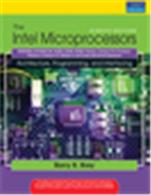The Intel Microprocessors: 8086/8088, 80186/80188, 80286, 80386, 80486, Pentium, Pentium Pro Processor, Pentium II, Pentium III, Pentium 4, and Core2 with 64-bit Extensions, 8/e

|
Author(s):
Author:
Barry B. Brey
- ISBN:9788131726228
- 10 Digit ISBN:8131726223
-
Price:Rs. 1280.00
- Pages:944
- Imprint:Pearson Education
- Binding:Paperback
- Status:Available
-
|
The Intel Microprocessors: 8086/8088, 80186/80188, 80286, 80386, 80486, Pentium, Pentium Pro Processor, Pentium II, Pentium III, Pentium 4, and Core2 with 64-bit Extensions, 8e, provides a comprehensive view of programming and interfacing of the Intel family of Microprocessors from the 8088 through the latest Pentium 4 and Core2 microprocessors. The text is written for students who need to learn about the programming and interfacing of Intel microprocessors, which have gained wide and at times exclusive application in many areas of electronics, communications, and control systems, particularly in desktop computer systems. Many applications include Visual C++ as a basis for learning assembly language using the inline assembler. Organized in an orderly and manageable format, this text offers more than 200 programming examples using the Microsoft Macro Assembler program and provides a thorough description of each of the Intel family members, memory systems, and various I/O systems.
Table of Content
- Introduction to the Microprocessor and Computer
- The Microprocessor and Its Architecture
- Addressing Modes
- Data Movement Instructions
- Arithmetic and Logic Instructions
- Program Control Instructions
- Using Assembly Language With C/C++
- Programming The Microprocessor
- 8086/8088 Hardware Specifications
- Memory Interface
- Basic I/O Interface
- Interrupts
- Direct Memory Access and Dma-Controlled I/O
- The Arithmetic Coprocessor, Mmx, and Simd Technologies
- Bus Interface
- The 80185, 80188, and 80286 Microprocessors
- The 80386 and 80486 Microprocessors
- The Pentium and Pentium Pro Microprocessors
- The Pentium II, Pentium III, Pentium 4, and Core2 Microprocessors
|
Salient Features
- Illustrated concepts for students with relevant programming examples, many written in Visual C++ with embedded assembly language code.
- Coverage of how to develop software to control application interfaces to the microprocessor.
- Coverage of how to program the microprocessor using the popular Microsoft Visual C programming environment with embedded assembly language to control personal computers.
- Descriptions of how to use real mode (DOS) and protected mode (Windows) of the microprocessor.
- Explanation of the operation of a real-time operating system (RTOS) in an embedded environment.
|
|
|
|
|